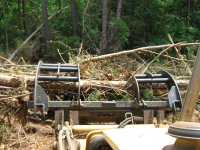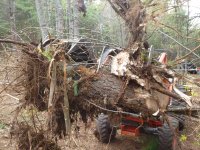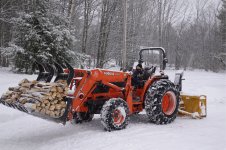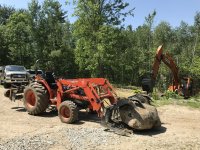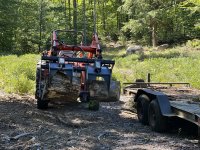As others have already noted, it really depends on what you want to do with the grapple. My primary use is moving long logs. A secondary use is to clean up brush and slash after logging and firewood harvesting. I need to maneuver in tight quarters in my woods. Driving around with my 66" wide bucket sometimes takes more maneuvering just to get that bucket around trees that I don't want to damage.
I went with a Sundown GR40 forestry grapple (similar to the Frostbite that
@fruitcakesa mentioned, though I have to admit, I do like the construction details on the Frostbite a little bit better.) These grapples excel at gripping long logs and holding them securely. To match that gripping in a non-forestry grapple, I'd have had to go with a double lid design. (Some single lid designs will pinch one end of a log, but not grip the other securely, allowing it to swing around.) That's a whole lot more weight and a lot more expense, and I'd lose some of the maneuverability in tight conditions that the forestry grapple allows. The forestry grapple weighs almost the same as the bucket it replaces.
View attachment 842193
A forestry grapple is more of a specialized implement: It's great for moving long logs and similar long objects. It works well for brush and slash, as long as it it not cut up into really short pieces. It does not do well on small items like firewood cut to 16" lengths or smaller rocks. You can't really "rake" with a forestry grapple. You also lose the ability to carry tools or other supplies which a bucket or some other style grapples allow fairly easily. (I've thought of making a box to carry in my forestry grapple to bring tools and supplies out to the work site, but it's not been enough of a problem to rise to the top of my to-do list. I added a couple of chainsaw carriers to my tractor and a receiver hitch to my logging winch so I can tow a trailer out to the worksite and still have my winch with me.
If I needed to do a lot of other grapple type work, I'd have a different style grapple (or maybe an
additional grapple?) However, since very little of my work is out in wide open areas, I would not be at all interested in a grapple that is wider than my tractor (or even one that covers my tracks).
